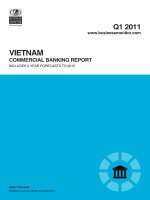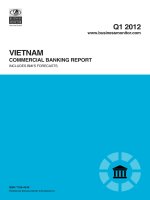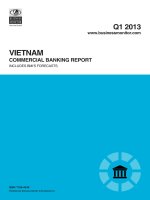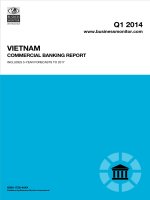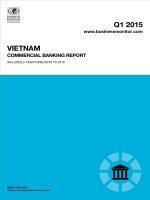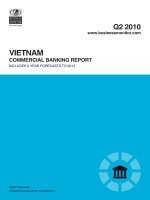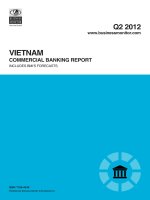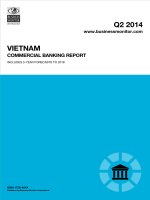Vietnam commercial banking report q1 2013
Bạn đang xem bản rút gọn của tài liệu. Xem và tải ngay bản đầy đủ của tài liệu tại đây (483.77 KB, 65 trang )
Q1 2013
www.businessmonitor.com
COMMERCIAL BANKING REPORT
ISSN 1758-454X
Published by Business Monitor International Ltd.
VIETNAM
INCLUDES BMI'S FORECASTS
Business Monitor International
85 Queen Victoria Street
London
EC4V 4AB
UK
Tel: +44 (0) 20 7246 5162
Fax: +44 (0) 20 7248 0467
Email:
Web: www.businessmonitor.com
© 2012 Business Monitor International.
All rights reserved.
All information contained in this publication is
copyrighted in the name of Business Monitor
International, and as such no part of this publication
may be reproduced, repackaged, redistributed, resold in
whole or in any part, or used in any form or by any
means graphic, electronic or mechanical, including
photocopying, recording, taping, or by information
storage or retrieval, or by any other means, without the
express written consent of the publisher.
DISCLAIMER
All information contained in this publication has been researched and compiled from sources believed to be accurate and reliable at the time of
publishing. However, in view of the natural scope for human and/or mechanical error, either at source or during production, Business Monitor
International accepts no liability whatsoever for any loss or damage resulting from errors, inaccuracies or omissions affecting any part of the
publication. All information is provided without warranty, and Business Monitor International makes no representation of warranty of any kind as
to the accuracy or completeness of any information hereto contained.
VIETNAM COMMERCIAL
BANKING REPORT Q1 2013
INCLUDES 5-YEAR FORECASTS TO 2017
Part of BMI’s Report & Forecasts Series
Published by: Business Monitor International
Copy deadline: December 2012
Vietnam Commercial Banking Report Q1 2013
© Business Monitor International Ltd Page 2
Vietnam Commercial Banking Report Q1 2013
© Business Monitor International Ltd Page 3
CONTENTS
Executive Summary 5
Table: Levels (VNDbn) 5
Table: Levels (US$bn) 5
Table: Levels At May 2012 5
Table: Annual Growth Rate Projections 2012-2017 (%) 6
Table: Ranking Out Of 59 Countries Reviewed In 2013 6
Table: Projected Levels (VNDbn), 2010-2017 6
Table: Projected Levels (US$bn), 2010-2017 6
SWOT Analysis 7
Vietnam Commercial Banking SWOT 7
Vietnam Political SWOT 7
Vietnam Economic SWOT 8
Vietnam Business Environment SWOT 9
Business Environment Outlook 10
Commercial Banking Business Environment Rating 10
Table: Commercial Banking Business Environment Ratings 10
Commercial Banking Business Environment Rating Methodology 10
Table: Asia Commercial Banking Business Environment Ratings 12
Global Commercial Banking Outlook 13
Regional Outlooks 17
Headwinds Gather Despite Benign Figures 17
Asia Banking Sector Outlook 19
Table: Banks' Bond Portfolios 2011 19
Table: Asia Commercial Banking Business Environment Ratings 20
Table: Comparison of Loan/Deposit & Loan/Asset & Loan/GDP ratios 21
Table: Anticipated Developments in 2013 22
Table: Comparison of Total Assets & Client Loans & Client Deposits (US$bn) 23
Table: Comparison of US$ Per Capita Deposits (2013) 24
Table: Interbank Rates and Bond Yields 25
Vietnam Banking Sector Outlook 26
Banking Sector: Assessing Crisis Potential 26
Economic Outlook 29
Table: Vietnam – Economic Activity, 2008-2016 31
Competitive Landscape 32
Market Structure 32
Protagonists 32
Table: Protagonists In Vietnam's Commercial Banking Sector 32
Definition Of The Commercial Banking Universe 32
List Of Banks 33
Table: Financial Institutions In Vietnam 33
Vietnam Commercial Banking Report Q1 2013
© Business Monitor International Ltd Page 4
Company Profiles 36
Bank for Foreign Trade of Vietnam (Vietcombank) 36
Table: Vietnam Stock Market Indicators, 2009-2012 37
Table: Vietnam Balance Sheet (US$mn), 2002-2010 37
Table: Vietnam Key Ratios (%), 2002-2010 37
VietinBank 38
Table: Key Statistics For VietinBank, 2005-2008 (VNDmn) 39
Agribank 40
Table: Vietnam Balance Sheet (LCYmn), 2004-2009 41
Table: Vietnam Balance Sheet (US$mn), 2004-2009 41
Table: Vietnam Key Ratios (%), 2004-2009 41
Asia Commercial Bank 42
Table: Vietnam Stock Market Indicators, 2007-2012 43
Table: Vietnam Balance Sheet (LCYmn), 2004-2010 43
Table: Vietnam Balance Sheet (US$mn), 2004-2010 44
Table: Vietnam Key Ratios (%), 2004-2010 44
Eximbank - 45
Table: Balance Sheet (VNDmn, unless stated), 2005-2008 46
Table: Balance Sheet (US$mn, unless stated), 2005-2008 46
Table: Key Ratios (%), 2005-2008 46
Vietnam Technological and Commercial Joint-stock Bank (Techcombank) 47
Table: Vietnam Balance Sheet (LCYmn), 2002-2009 48
Table: Vietnam Balance Sheet (US$mn), 2002-2009 48
Table: Vietnam Key Ratios (%), 2002-2009 48
Viet A Joint Stock Commercial Bank (Vietabank) 49
Table: Vietnam Stock Market Indicators, 2009-2012 50
Table: Vietnam Balance Sheet (LCYmn), 2005-2010 50
Table: Vietnam Balance Sheet (US$mn), 2005-2010 50
Table: Vietnam Key Ratios (%), 2005-2010 51
Housing Development Commercial Joint Stock Bank (HDBank) 52
Sacombank 53
Table: Stock Market Indicators, 2007-2010 54
Table: Balance Sheet (VNDmn, unless stated), 2005-2009 54
Table: Balance Sheet (US$mn, unless stated), 2005-2009 55
Table: Key Ratios (%), 2005-2009 55
Demographic Outlook 56
Table: Vietnam's Population By Age Group, 1990-2020 ('000) 57
Table: Vietnam's Population By Age Group, 1990-2020 (% of total) 58
Table: Vietnam's Key Population Ratios, 1990-2020 59
Table: Vietnam's Rural And Urban Population, 1990-2020 59
BMI Banking Sector Methodology 60
Table: Commercial Banking Risk/Reward Rating Indicators And Rationale 62
Table: Weighting Of Indicators 63
Vietnam Commercial Banking Report Q1 2013
© Business Monitor International Ltd Page 5
Executive Summary
Table: Levels (VNDbn)
Date Total assets Client loans
Bond
portfolio Other
Liabilities
and capital Capital
Client
deposits
Other
May 2011 3,117,942.0
2,630,220.0
223,644.0
264,078.0
3,117,942.0
494,104.0
2,241,245.1
382,592.9
May 2012 3,545,800.5
2,835,610.0
355,353.5
354,837.0
3,545,800.5
569,584.0
2,668,470.8
307,745.7
Change, % 13.7%
8%
59%
34%
14%
15%
19%
-20%
Source: BMI; Central banks; Regulators
Table: Levels (US$bn)
Date
Total
assets
Client
loans
Bond
portfolio
Other
Liabilities
and capital
Capital
Client
deposits
Other
May 2011 151.6
127.9
10.9
12.8
151.6
24.0
109.0
18.6
May 2012 170.3
136.2
17.1
17.0
170.3
27.4
128.1
14.8
Change, % 12%
6%
57%
33%
12%
14%
18%
-21%
Source: BMI; Central banks; Regulators
Table: Levels At May 2012
Loan/deposit ratio
Loan/asset ratio
Loan/GDP ratio
GDP
Per Capita,
US$
Deposits per capita,
US$
106.26% 79.97%
n.a.
1,072
1,437
Falling Falling
Falling
Source: BMI; Central banks; Regulators
Vietnam Commercial Banking Report Q1 2013
© Business Monitor International Ltd Page 6
Table: Annual Growth Rate Projections 2012-2017 (%)
Assets
Loans
Deposits
Annual Growth Rate 11
9
6
CAGR 13
11
8
Ranking 16
23
35
Source: BMI; Central banks; Regulators
Table: Ranking Out Of 59 Countries Reviewed In 2013
Loan/deposit ratio Loan/asset ratio
Loan/GDP ratio
12 2
14
Local currency asset growth Local currency loan growth
Local currency deposit growth
12 16
22
Source: BMI; Central banks; Regulators
Table: Projected Levels (VNDbn), 2010-2017
2010
2011e
2012f
2013f
2014f
2015f
2016f
2017f
Total assets 2,953,153.46
3,437,893.00
3,816,061.23
4,350,309.80
4,959,353.17
5,604,069.09
6,276,557.38
6,966,978.69
Client loans 2,475,540.00
2,829,890.00
3,084,580.10
3,454,729.71
3,869,297.28
4,294,919.98
4,724,411.98
5,149,609.05
Client deposits 2,209,896.20
2,483,357.20
2,706,859.35
2,977,545.28
3,245,524.36
3,505,166.31
3,750,527.95
3,975,559.63
e/f = estimate/forecast. Source: BMI; Central banks; Regulators
Table: Projected Levels (US$bn), 2010-2017
2010
2011e
2012f
2013f
2014f
2015f
2016f
2017f
Total assets 151.46
163.44
181.41
209.15
241.16
275.66
312.27
348.35
Client loans 126.96
134.53
146.64
166.09
188.15
211.26
235.05
257.48
Client deposits 113.34
118.06
128.68
143.15
157.82
172.41
186.59
198.78
e/f = estimate/forecast. Source: BMI; Central banks; Regulators
Vietnam Commercial Banking Report Q1 2013
© Business Monitor International Ltd Page 7
SWOT Analysis
Vietnam Commercial Banking SWOT
Strengths
Rapid growth.
Untapped potential.
High savings rate of Vietnamese.
Weaknesses
Domestic banks lack capital and technology to sustain high credit growth.
The financial accounts of many banks are still opaque.
Opportunities
Population still underbanked.
Income levels likely to rise strongly over the medium term.
Threats
Macroeconomic instabilities threatens the credibility of the government and could
potentially economic policy away from further liberalisation.
Vietnam Political SWOT
Strengths
The Communist Party of Vietnam remains committed to market-oriented reforms and
we do not expect major shifts in policy direction over the next five years. The one-
party system is generally conducive to short-term political stability.
Relations with the US have witnessed a marked improvement, and Washington sees
Hanoi as a potential geopolitical ally in South East Asia.
Weaknesses
Corruption among government officials poses a major threat to the legitimacy of the
ruling Communist Party.
There is increasing (albeit still limited) public dissatisfaction with the leadership's tight
control over political dissent.
Opportunities
The government recognises the threat corruption poses to its legitimacy, and has
acted to clamp down on graft among party officials.
Vietnam has allowed legislators to become more vocal in criticising government
policies. This is opening up opportunities for more checks and balances within the
one-party system.
Threats
Macroeconomic instabilities in 2012 are likely to weigh on public acceptance of the
one-party system, and street demonstrations to protest economic conditions could
develop into a full-on challenge of undemocractic rule.
Although strong domestic control will ensure little change to Vietnam's political scene
in the next few years, over the longer term, the one-party-state will probably be
unsustainable.
Relations with China have deteriorated over recent years due to Beijing's more
assertive stance over disputed islands in the South China Sea and domestic criticism
of a large Chinese investment into a bauxite mining project in the central highlands,
which could potentially cause wide-scale environmental damage.
Vietnam Commercial Banking Report Q1 2013
© Business Monitor International Ltd Page 8
Vietnam Economic SWOT
Strengths
Vietnam has been one of the fastest-growing economies in Asia in recent years, with
GDP growth averaging 7.1% annually between 2000 and 2011.
The economic boom has lifted many Vietnamese out of poverty, with the official
poverty rate in the country falling from 58% in 1993 to 14.0% in 2010.
Weaknesses
Vietnam still suffers from substantial trade, current account and fiscal deficits, leaving
the economy vulnerable to global economic uncertainties in 2012. The fiscal deficit is
dominated by substantial spending on social subsidies that could be difficult to
withdraw.
The heavily-managed and weak currency reduces incentives to improve quality of
exports, and also keeps import costs high, contributing to inflationary pressures.
Opportunities
WTO membership has given Vietnam access to both foreign markets and capital,
while making Vietnamese enterprises stronger through increased competition.
The government will in spite of the current macroeconomic woes, continue to move
forward with market reforms, including privatisation of state-owned enterprises, and
liberalising the banking sector.
Urbanisation will continue to be a long-term growth driver. The UN forecasts the
urban population rising from 29% of the population to more than 50% by the early
2040s.
Threats
Inflation and deficit concerns have caused some investors to re-assess their hitherto
upbeat view of Vietnam. If the government focuses too much on stimulating growth
and fails to root out inflationary pressure, it risks prolonging macroeconomic
instability, which could lead to a potential crisis.
Prolonged macroeconomic instability could prompt the authorities to put reforms on
hold as they struggle to stabilise the economy.
Vietnam Commercial Banking Report Q1 2013
© Business Monitor International Ltd Page 9
Vietnam Business Environment SWOT
Strengths
Vietnam has a large, skilled and low-cost workforce, that has made the country
attractive to foreign investors.
Vietnam's location – its proximity to China and South East Asia, and its good sea
links – makes it a good base for foreign companies to export to the rest of Asia, and
beyond.
Weaknesses
Vietnam's infrastructure is still weak. Roads, railways and ports are inadequate to
cope with the country's economic growth and links with the outside world.
Vietnam remains one of the world's most corrupt countries. According to
Transparency International's 2011 Corruption Perceptions Index, Vietnam ranks 112
out of 183 countries.
Opportunities
Vietnam is increasingly attracting investment from key Asian economies, such as
Japan, South Korea and Taiwan. This offers the possibility of the transfer of high-
tech skills and know-how.
Vietnam is pressing ahead with the privatisation of state-owned enterprises and the
liberalisation of the banking sector. This should offer foreign investors new entry
points.
Threats
Ongoing trade disputes with the US, and the general threat of American
protectionism, which will remain a concern.
Labour unrest remains a lingering threat. A failure by the authorities to boost skills
levels could leave Vietnam a second-rate economy for an indefinite period.
Vietnam Commercial Banking Report Q1 2013
© Business Monitor International Ltd Page 10
Business Environment Outlook
Commercial Banking Business Environment Rating
Table: Commercial Banking Business Environment Ratings
Limits of potential returns
Data
Score; out of 10
Ratings score; out of 100
Total assets; end 2012, US$bn 163.4
6
Market Structure 60
Growth in total assets; 2012-2017, US$bn 130.9
6
Growth in client loans; 2012-2017, US$bn 88.4
6
Per-capita GDP; 2012, US$ 1,530.3
3
Country Structure 55
Tax 2.9
3
GDP volatility 0.9
10
Financial infrastructure 5.6
6
Risks to realisation of returns
Regulatory framework and development 2.0
2
Market Risk 37
Regulatory framework and competitive landscape 5.0
5
Moody's rating for local currency deposits 3.5
4
Long-term financial risk 4.6
5
Country Risk 48
Long-term external risk 3.7
4
Long-term policy continuity 7.0
7
Legal framework 3.7
4
Bureaucracy 3.9
4
Commercial banking business environment rating
54
Source: BMI, National Sources
Commercial Banking Business Environment Rating Methodology
Since Q108, we have described numerically the banking business environment for each of the countries
surveyed by BMI. We do this through our Commercial Banking Business Environment Rating (CBBER),
a measure that ensures we capture the latest quantitative information available. It also ensures consistency
across all countries and between the inputs to the CBBER and the Insurance Business Environment
Rating, which is likewise now a feature of our insurance reports. Like the Business Environment Ratings
calculated by BMI for all the other industries on which it reports, the CBBER takes into account the limits
Vietnam Commercial Banking Report Q1 2013
© Business Monitor International Ltd Page 11
of potential returns and the risks to the realisation of those returns. It is weighted 70% to the former and
30% to the latter.
The evaluation of the 'Limits of potential returns' includes market elements that are specific to the
banking industry of the country in question and elements that relate to that country in general. Within the
70% of the CBBER that takes into account the 'Limits of potential returns', the market elements have a
60% weighting and the country elements have a 40% weighting. The evaluation of the 'Risks to
realisation of returns' also includes banking elements and country elements (specifically, BMI's
assessment of long-term country risk). However, within the 30% of the CBBER that take into account the
risks, these elements are weighted 40% and 60%, respectively.
Further details on how we calculate the CBBER are provided at the end of this report. In general, though,
three aspects need to be borne in mind in interpreting the CBBERs. The first is that the market elements
of the 'Limits of potential returns' are by far the most heavily weighted of the four elements. They account
for 60% of 70% (or 42%) of the overall CBBER. Second, if the market elements are significantly higher
than the country elements of the 'Limits of potential returns', it usually implies that the banking sector is
(very) large and/or developed relative to the general wealth, stability and financial infrastructure in the
country. Conversely, if the market elements are significantly lower than the country elements, it usually
means that the banking sector is small and/or underdeveloped relative to the general wealth, stability and
financial infrastructure in the country. Third, within the 'Risks to the realisation of returns' category, the
market elements (i.e. how regulations affect the development of the sector, how regulations affect
competition within it, and Moody's Investor Services' ratings for local currency deposits) can be markedly
different from BMI's long-term risk rating.
Vietnam Commercial Banking Report Q1 2013
© Business Monitor International Ltd Page 12
Table: Asia Commercial Banking Business Environment Ratings
Limits of Potential Returns Risks to Potential Returns Overall
Market
Structure
Country
Structure
Market Risks
Country Risks
Rating
Ranking
Bangladesh 46.7
45.0
43.3
44.0
45.3
55
China 93.3
55.0
63.3
74.0
75.5
13
Hong Kong 76.7
92.5
73.3
78.0
80.9
7
India 83.3
55.0
60.0
54.0
67.3
29
Indonesia 76.7
65.0
80.0
52.0
69.4
25
Japan 33.3
77.5
66.7
80.0
58.1
36
Malaysia 73.3
80.0
83.3
80.0
77.6
10
Pakistan 43.3
50.0
53.3
42.0
46.2
52
Philippines 50.0
62.5
60.0
58.0
56.1
39
Singapore 53.3
95.0
96.7
90.0
76.8
11
Sri Lanka 23.3
55.0
33.3
46.0
37.5
57
South Korea 80.0
82.5
83.3
76.0
80.4
8
Taiwan 76.7
70.0
86.7
76.0
75.9
12
Thailand 66.7
65.0
86.7
74.0
69.9
21
Vietnam 60.0
55.0
36.7
48.0
53.6
43
United States 90.0
85.0
100.0
80.0
88.0
2
Scores out of 100, with 100 the highest. Source: BMI
Vietnam Commercial Banking Report Q1 2013
© Business Monitor International Ltd Page 13
Global Commercial Banking Outlook
In general our country banking sector forecasts incorporate faster growth in emerging markets than in
developed states, but the years ahead are unlikely to be as dynamic as the pre-2008 crisis era in terms of
banking sector growth. Furthermore, impaired private sector balance sheets, combined with increasingly
onerous regulations on capital adequacy ratios and lending standards, will constrain earnings growth for
years to come in developed states. On the positive side, monetary policy is set to remain very
accommodative in developed states, and is likely to become increasingly so in emerging markets, which
should mitigate negative tail risks to the global financial sector.
Developed States Outlook
While the US banking sector recovery remains tentative, we believe the US banking sector has turned the
corner, and we continue to project steady lending and asset growth in 2013 and beyond. In contrast,
capital flight is crippling peripheral eurozone banking sectors while leaving the German banking industry
inundated with deposits. The result is an increasingly skewed banking system in which the periphery is
becoming ever more dependent on the European Central Bank (ECB)'s liquidity provisions, while
German banks are facing expanding balance sheets.
Against this backdrop, in line with our view, the major theme in developed states in the latter half of 2012
has been monetary easing, which has further loosened liquidity conditions and helped push back the
dangers facing the eurozone financial system. The ECB was the first to deliver a major new policy
announcement on September 6, with a newly devised framework to buy up encumbered debt from the
eurozone periphery was nonetheless its boldest decision yet. The central bank will now purchase
'unlimited' amounts of government debt provided that the sovereign issuer in question first commits to a
structural macroeconomic adjustment program.
A week later, the US Federal Reserve pulled the trigger on direct monetary expansion. The Federal Open
Market Committee (FOMC) announced on September 13 that the central bank would commence open-
ended purchases of mortgage-backed securities to the tune of US$40bn a month. The programme will
continue indefinitely until the economic recovery has taken root. Indeed, though we had expected QE3 to
be implemented at around this time, what was most surprising about the decision was that the FOMC said
that 'a highly accommodative stance of monetary policy will remain appropriate for a considerable time
after the economic recovery strengthens', suggesting an unprecedented commitment to policy easing. In
addition, the Fed will continue with Operation Twist and indicated that the Fed Funds rate would be
anchored at 0-0.25% until at least mid-2015. We have pushed back our expectations for Fed hiking
accordingly, with the first Fed funds hike only in 2016, as opposed to late 2014 in our previous set of
forecasts.
Vietnam Commercial Banking Report Q1 2013
© Business Monitor International Ltd Page 14
Fed Ups The Ante
US – S&P 500 Equity Index & Fed Purchases, Rebased Jan 2008 = 100
Source: ONS, Fed, Bloomberg
Following on the heels of the Fed, the Bank of Japan (BoJ) announced an additional round of quantitative
easing on September 19, pledging to increase purchases of government securities by JPY10trn to
JPY80trn by end-2013 (pushed back from the previous June 2013 deadline). The Bank of England (BoE)
has yet to follow suit, but we expect the Asset Purchase Program ceiling to be raised to GBP500bn by end
year from GBP325bn at present.
These easing measures will not prove a panacea to credit growth in developed states, as private sector
balance sheets remain impaired and the deleveraging trend remains in place. However, they do help
mitigate some of the negative tail risks.
Emerging Market Regional Outlooks
On a region-by-region basis, the risks to emerging commercial banking sectors come largely from abroad,
with economic growth in Europe, the US and China all set to slow, and the eurozone crisis set to persist.
Latin America and Sub-Saharan African banking sectors have arguably the brightest outlook on a
regional basis, with a more mixed picture for Asia, Europe and the Middle East and North Africa.
Emerging Asia: The three threats of foreign funding constraints, slower credit growth, and higher non-
performing loans (NPLs) continue to form a cloud over the outlook for Asia's banking sector. Despite
recent weakness in economic growth, the sector has held up well, but we believe these headwinds will
continue to gather pace. The regional trade cycle is rolling over and, although Asian banks are taking a
growing piece of the global trade financing pie, this is set to shrink in absolute terms. Domestically,
Vietnam Commercial Banking Report Q1 2013
© Business Monitor International Ltd Page 15
housing loans, which have dominated total loan growth, are set to fall as property valuations in markets
such as China, Hong Kong, Singapore and Malaysia, together with stricter regulations, undermines
mortgage demand.
Slowdown Set To Intensify
Asia – Simple Average Credit Growth, % chg y-o-y
Source: BMI, Regional Central Banks
Emerging Europe: While Turkey remains our clear favourite among Emerging European banking
sectors, we now see more value in Czech banks than Polish banks, although we still like the Polish story
over a longer-term time horizon. Russia's banking sector, on the other hand, has fallen out of favour, as
we believe the country's credit cycle has now peaked, and expect investors to ask more questions about
the quality of incumbents' loan portfolios over the next few months. On balance we believe regional
banks offer more risks than opportunities, with Ukrainian and Kazakh banking sectors most at risk.
Latin America: Commercial banking sectors across Latin America continue to hold significant value
over the next five years, as we see room for growth in banks' loan portfolios over the coming years. While
we differentiate among regional banking sectors on the grounds of shifting growth dynamics in Latin
America, and various degrees of exposure to falling external demand for industrial metals and a high
degree of government intervention, we believe that global rebalancing pressures will steadily push Latin
American consumers into the economic spotlight. This will underpin a gradual convergence process with
developed markets, as household and mortgage loans begin to grow as a share of total banking sector
assets. Mexico and Colombia are the most likely to experience robust sustainable growth over the next
few years, while Argentine and Venezuelan banks will suffer at the hands of sizeable currency
devaluations in 2013.
Vietnam Commercial Banking Report Q1 2013
© Business Monitor International Ltd Page 16
Mexico Has A Long Way To Go
Latin America – Banking Sector Asset & Client Loan Growth, 5-Year CAGR % in
2011
Source: BMI, Respective central banks
Middle East And North Africa: The prospects for commercial banks in MENA remain mixed. Our
outlook for financial institutions in the Gulf Cooperation Council (GCC) is broadly positive, with large-
scale government spending on infrastructure projects helping to facilitate a steady expansion in credit
growth. Moreover, threats to stability remain low compared to the rest of the region as a result of robust
balance sheet positions and minimal exposure to the eurozone sovereign debt crisis. That said, over the
coming months we expect credit growth to continue slowing (most notably in Qatar and Oman – two of
the regional outperformers) although this is, to a certain extent, simply a product of base effects following
several quarters of rapid growth. In contrast, financial institutions outside the GCC remain in a precarious
position, with credit growth remaining generally anaemic, and significant risks to sectoral stability
stemming from the highly uncertain political and macroeconomic backdrop still pronounced. In
particular, we would highlight that Iran's banking sector is potentially in the midst of a full-blown crisis,
while the government is in no position to offer any type of bailout.
Vietnam Commercial Banking Report Q1 2013
© Business Monitor International Ltd Page 17
Regional Outlooks
Headwinds Gather Despite Benign Figures
BMI View: The three threats of foreign funding constraints, slower credit growth, and higher non-
performing loans (NPLs) continue to form a cloud over the outlook for Asia's banking sector. Despite
recent weakness in economic growth, the sector has held up well, but we believe these headwinds will
continue to gather pace.
In March of this year we outlined three major risks facing banks across Asia; foreign funding constraints,
slower credit growth, and higher NPLs. We argued that these headwinds would undermine financial
sector earnings as the region experienced a slowdown in economic activity. Seven months on, we can
claim that loan growth has indeed slowed, but not by as much as we originally expected. NPLs,
meanwhile, have not yet seen the uptick we were expecting, while foreign funding concerns have eased.
On the whole, the financial sector appears to be holding up relatively well in spite of clear weakness in
regional economic activity. However, we believe that the aforementioned headwinds are as significant as
ever.
Credit Growth Declining But Staying Sticky
After peaking at 19.2% y-o-y in May 2011, average loan growth across Asia (using a simple rather than
GDP weighted average) has steadily fallen. However, it remains elevated at 15.5% and we believe that
further declines are in store over the coming quarters. The regional trade cycle is rolling over and,
although Asian banks are taking a growing piece of the global trade financing pie, this is set to shrink in
absolute terms. Domestically, housing loans, which have dominated total loan growth, are set to fall as
property valuations in markets such as China, Hong Kong, Singapore and Malaysia, together with stricter
regulations, undermines mortgage demand.
Vietnam Commercial Banking Report Q1 2013
© Business Monitor International Ltd Page 18
Slowdown Set To Intensify
Asia – Simple Average Credit Growth, % chg y-o-y
Source: BMI, Regional Central Banks
NPLs Minimal, For Now
Contrary to our expectations, NPLs have continued to decline across the region, with ratios hitting multi-
year lows in a number of countries. South East Asian countries are currently experiencing very low rates
of NPLs, averaging around just 2% of total loans. As NPLS are often a lagging indicator, though, we do
not believe these positive figures provide much reason for cheer. Indeed, if we consider that overall
average credit growth is still in double digits, it makes sense that there is little credit stress. Furthermore,
data is only available up to mid-year, meaning that the recent slump in regional trade is yet to show up in
the data. As credit growth cools, NPLs should begin to head higher over the coming quarters.
Foreign Funding Could Dry Up
With global central banks providing record amounts of liquidity, implied volatility has been suppressed
across the region, helping to narrow basis swaps materially and improving funding costs. However, we
see underlying risks lurking as the risk of global financial instability appears to be significantly
underappreciated at present. As we have argued previously, Asian banks are now sitting on very high FX
loans to deposit ratios (see 'Trade Finance Growth Set To Slow', April 25). For the region as a whole we
estimate the total FX loan-to-deposit ratio is in excess of 100% as a result of double-digit FX loan growth
in 2011. This makes short-term funding, mainly in US dollars, crucial to keeping these loan levels
elevated, and here the risks are noteworthy. With Asian banks using swap agreements with their US
counterparts to fund lending, a rise in swap spreads represents a major risk, which could weigh on
margins and also lead to a slowdown in FX lending over the coming months.
Vietnam Commercial Banking Report Q1 2013
© Business Monitor International Ltd Page 19
Asia Banking Sector Outlook
Table: Banks' Bond Portfolios 2011
Bond Portfolio, US$bn Bond as % total assets Year-on-year growth %
Bangladesh 17.1
23.0
19.3
China 1,575.8
8.7
-4.2
Hong Kong 350.0
19.8
3.4
India 292.0
25.2
7.9
Indonesia 17.3
4.3
17.7
Japan 3,408.3
30.8
7.5
Malaysia 67.9
12.5
3.1
Pakistan 33.5
38.5
56.1
Philippines 35.4
23.7
-4.3
Singapore 76.5
11.6
5.5
Sri Lanka 2.2
12.8
22.2
South Korea 269.8
17.0
4.6
Taiwan 97.9
8.4
-47.2
Thailand 65.5
15.9
13.7
Vietnam 12.3
7.5
27.0
United States 447.1
3.6
-15.1
Source: Central banks, regulators, BMI
Vietnam Commercial Banking Report Q1 2013
© Business Monitor International Ltd Page 20
Table: Asia Commercial Banking Business Environment Ratings
Limits of Potential Returns Risks to Potential Returns Overall
Market
Structure
Country
Structure
Market Risks
Country
Risks
Rating
Ranking
Bangladesh 46.7
45.0
43.3
44.0
45.3
55
China 93.3
55.0
63.3
74.0
75.5
13
Hong Kong 76.7
92.5
73.3
78.0
80.9
7
India 83.3
55.0
60.0
54.0
67.3
29
Indonesia 76.7
65.0
80.0
52.0
69.4
26
Japan 33.3
77.5
66.7
80.0
58.1
36
Malaysia 73.3
80.0
83.3
80.0
77.6
10
Pakistan 43.3
50.0
53.3
42.0
46.2
52
Philippines 50.0
62.5
60.0
58.0
56.1
39
Singapore 53.3
95.0
96.7
90.0
76.8
11
Sri Lanka 20.0
55.0
33.3
46.0
36.1
58
South Korea 80.0
82.5
83.3
76.0
80.4
8
Taiwan 76.7
70.0
86.7
76.0
75.9
12
Thailand 66.7
65.0
86.7
74.0
69.9
23
Vietnam 60.0
55.0
36.7
48.0
53.6
43
United States 90.0
85.0
100.0
80.0
88.0
2
Scores out of 100, with 100 the highest. Source: BMI
Vietnam Commercial Banking Report Q1 2013
© Business Monitor International Ltd Page 21
Table: Comparison of Loan/Deposit & Loan/Asset & Loan/GDP ratios
Loan
deposit
ratio %
Rank
Trend
Loan/As
set ratio
%
Rank
Trend
Loan/GD
P ratio %
Rank
Trend
Bangladesh 93.8
35
Falling
67.1
13
Falling
52.3
41
Rising
China 75.6
50
Rising
49.8
43
Falling
131.9
9
Rising
Hong Kong 66.9
56
Rising
37.0
58
Rising
256.6
2
Rising
India 75.8
49
Rising
66.1
14
Rising
49.4
45
Rising
Indonesia 83.7
43
Rising
62.8
24
Rising
33.1
54
Rising
Japan 69.9
54
Falling
49.6
44
Falling
89.2
23
Rising
Malaysia 78.4
48
Falling
58.6
37
Falling
121.6
11
Rising
Pakistan 60.9
60
Falling
45.2
49
Falling
20.1
58
Falling
Philippines 72.8
52
Rising
53.5
40
Rising
35.5
52
Rising
Singapore 97.8
31
Rising
53.4
42
Rising
138.1
8
Rising
Sri Lanka 78.4
47
Rising
60.6
32
Rising
29.0
55
Rising
South Korea 116.5
12
Falling
72.0
8
Rising
104.7
15
Rising
Taiwan 78.8
46
Rising
62.3
28
Rising
160.9
5
Rising
Thailand 106.4
23
Rising
64.5
18
Rising
82.8
26
Rising
Vietnam 114.0
14
Rising
80.8
2
Falling
106.8
14
Falling
United States 109.2
18
Falling
76.0
4
Falling
62.4
35
Falling
Source: Central banks, regulators, BMI
Vietnam Commercial Banking Report Q1 2013
© Business Monitor International Ltd Page 22
Table: Anticipated Developments in 2013
Loan/Deposit
Ratio, %
Trend
Loan Growth,
US$bn
Deposit
Growth,
US$bn
Residual,
US$bn
Bangladesh 92.6
Falling
18.3
20.9
-2.6
China 74.9
Rising
1,850.7
1,672.1
178.6
Hong Kong 67.5
Rising
73.2
99.3
-26.1
India 75.8
Falling
361.6
476.9
-115.3
Indonesia 83.0
Rising
119.3
128.8
-9.5
Japan 68.9
Falling
201.8
479.9
-278.2
Malaysia 77.7
Falling
74.1
100.9
-26.7
Pakistan 57.7
Falling
0.8
15.2
-14.5
Philippines 72.5
Rising
17.2
17.5
-0.3
Singapore 92.0
Rising
64.0
67.6
-3.6
Sri Lanka 78.7
Falling
3.1
4.5
-1.4
South Korea 114.4
Falling
137.7
156.5
-18.8
Taiwan 80.7
Rising
147.0
147.7
-0.7
Thailand 106.9
Falling
40.6
42.5
-1.9
Vietnam 116.0
Rising
31.6
25.1
6.5
United States 108.7
Falling
1,019.2
1,140.8
-121.6
NB Incorporates estimated economic data and projected banking data. Source: Central banks, regulators, BMI
Vietnam Commercial Banking Report Q1 2013
© Business Monitor International Ltd Page 23
Table: Comparison of Total Assets & Client Loans & Client Deposits (US$bn)
2013 2012
Total
Assets
Client
Loans
Client
Deposits
Total
Assets
Client
Loans
Client
Deposits
Bangladesh 101.7
68.2
73.7
86.9
58.3
62.2
China 21,818.6
11,083.2
14,788.9
20,979.4
10,455.9
13,821.4
Hong Kong 1,949.0
727.3
1,076.7
1,821.2
673.3
1,006.1
India 1,704.9
1,126.3
1,485.3
1,347.6
890.3
1,174.0
Indonesia 586.1
361.7
435.7
472.5
296.5
354.2
Japan 11,530.1
5,708.0
8,280.0
11,438.6
5,673.9
8,117.6
Malaysia 662.9
388.3
499.8
583.8
342.0
436.2
Pakistan 104.9
44.6
76.6
93.5
42.2
67.5
Philippines 170.8
91.5
126.1
158.8
85.0
116.7
Singapore 741.9
388.3
422.3
719.0
383.7
392.3
Sri Lanka 32.3
19.8
25.2
28.3
17.2
21.9
South Korea 1,770.7
1,275.3
1,114.8
1,622.6
1,168.7
1,003.3
Taiwan 1,351.4
862.4
1,068.1
1,225.6
763.8
968.7
Thailand 481.6
312.0
291.8
440.6
284.1
266.9
Vietnam 209.1
166.1
143.2
181.4
146.6
128.7
United States 13,727.4
10,478.1
9,641.9
13,073.7
9,931.9
9,096.1
Source: Central banks, regulators, BMI
Vietnam Commercial Banking Report Q1 2013
© Business Monitor International Ltd Page 24
Table: Comparison of US$ Per Capita Deposits (2013)
GDP Per Capita
Client Deposits,
per capita
Rich 20% Client
Deposits, per
capita
Poor 80% Client
Deposits, per
capita
Bangladesh 813
442
1,909
119
China 6,428
8,153
43,517
2,720
Hong Kong 38,649
99,984
592,065
37,004
India 1,674
883
4,659
291
Indonesia 4,181
1,463
7,050
441
Japan 51,142
45,178
262,139
16,384
Malaysia 10,392
13,037
67,118
4,195
Pakistan 1,276
244
1,673
105
Philippines 2,648
932
5,140
321
Singapore 54,949
73,256
318,637
19,915
Sri Lanka 3,159
927
4,712
295
South Korea 24,926
26,147
91,421
5,714
Taiwan 22,710
37,016
183,386
11,462
Thailand 5,404
4,508
16,861
1,054
Vietnam 1,718
1,832
6,316
395
United States 52,285
32,899
121,092
7,568
Source: Central banks, regulators, BMI
